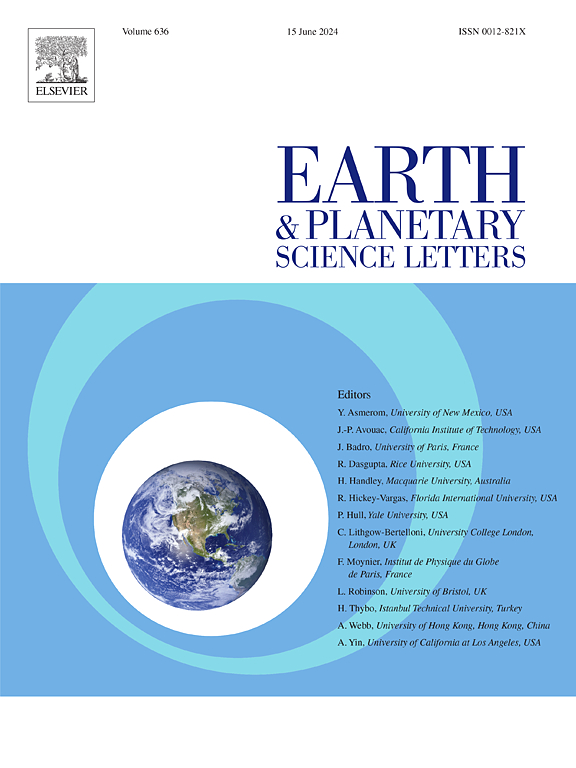Magmatic N2 degassing dominates nitrogen loss during sediment subduction and granitoid genesis
IF 4.8
1区 地球科学
Q1 GEOCHEMISTRY & GEOPHYSICS
引用次数: 0
Abstract
Subducting sediments contain much more abundant nitrogen (N) than the other slab components. The fate of sedimentary N along subduction directly determines the quantity of surficial N that can be released back to the atmosphere/crust or further delivered to the deep mantle, which has a strong impact on the long-term evolution of the N budgets and isotopic signatures of Earth's major reservoirs. Previous studies on the fate of subducted sedimentary N have been intensively focused on assessing the extent of metamorphic N devolatilization from metasedimentary rocks varying from ultrahigh-pressure eclogites facies (subducted to as deep as 90 km) in cold subduction zones to medium-pressure amphibolite facies in extremely hot subduction zones. However, the fate of sedimentary N after these metamorphic stages, particularly during sediment melting and subsequent magmatic crystallization, has not been examined so far. Here, we present the N data of the Cretaceous peraluminous granitoids in the Oman-United Arab Emirates area, which were formed by melting of subducted pelagic sediments followed by intrusion and crystallization in the lithospheric mantle before the entire lithospheric section was obducted to form the Oman-United Arab Emirates ophiolites. The 27 studied samples show surprisingly low N contents (4.0 - 13.7 ppm; mean: 6.9 ± 2.3 ppm; 1σ) and a narrow δ15N range (mostly in the range of –1.4‰ to +2.2‰; mean: +0.4 ± 1.5‰; 1σ). Data modeling indicates that the N in these granitoids contains little mantle contribution and was predominantly inherited from their source rocks. Compared with potential source rocks, these granitoids display orders of magnitude lower N contents but comparable δ15N values, indicating that the significant N loss during the genesis of these granitoids was associated with little N isotope fractionation. This suggests that magmatic N2 degassing (with minor N isotope fractionation) rather than metamorphic N devolatilization (with much larger N isotope fractionation) is the dominant mechanism driving the N loss from subducted sediments.
沉积物俯冲和花岗岩成因过程中,岩浆 N2 脱气主导了氮的损失
俯冲沉积物中含有比其他板块成分丰富得多的氮。沉积氮在俯冲过程中的去向直接决定了表层氮能够释放回大气/地壳或进一步输送到地幔深处的数量,这对地球主要储层的氮预算和同位素特征的长期演化有很大影响。以往对俯冲沉积 N 的归宿的研究主要集中在评估变质 N 从变质岩中脱落的程度,这些变质岩从寒冷俯冲带的超高压夕卡岩面(俯冲深度达 90 千米)到极热俯冲带的中压闪长岩面都有。然而,迄今为止还没有研究过沉积 N 在这些变质阶段之后的去向,特别是在沉积物熔融和随后的岩浆结晶过程中的去向。在此,我们介绍了阿曼-阿联酋地区白垩纪围岩花岗岩的氮数据,这些花岗岩是在整个岩石圈断面被俯冲形成阿曼-阿联酋蛇绿岩之前,由俯冲沉积物熔融后在岩石圈地幔中侵入和结晶形成的。所研究的 27 个样本显示出令人惊讶的低 N 含量(4.0 - 13.7 ppm;平均值:6.9 ± 2.3 ppm;1σ)和狭窄的 δ15N 范围(大部分在-1.4‰至 +2.2‰之间;平均值:+0.4 ± 1.5‰;1σ)。数据建模表明,这些花岗岩中的氮含量很少来自地幔,而主要来自其源岩。与潜在的源岩相比,这些花岗岩中的氮含量低了几个数量级,但δ15N值却相当,这表明这些花岗岩在成因过程中的大量氮损失与很少的氮同位素分馏有关。这表明,岩浆N2脱气(N同位素分馏小)而非变质N脱溶(N同位素分馏大得多)是驱动N从俯冲沉积物中流失的主要机制。
本文章由计算机程序翻译,如有差异,请以英文原文为准。
求助全文
约1分钟内获得全文
求助全文
来源期刊

Earth and Planetary Science Letters
地学-地球化学与地球物理
CiteScore
10.30
自引率
5.70%
发文量
475
审稿时长
2.8 months
期刊介绍:
Earth and Planetary Science Letters (EPSL) is a leading journal for researchers across the entire Earth and planetary sciences community. It publishes concise, exciting, high-impact articles ("Letters") of broad interest. Its focus is on physical and chemical processes, the evolution and general properties of the Earth and planets - from their deep interiors to their atmospheres. EPSL also includes a Frontiers section, featuring invited high-profile synthesis articles by leading experts on timely topics to bring cutting-edge research to the wider community.
 求助内容:
求助内容: 应助结果提醒方式:
应助结果提醒方式:


